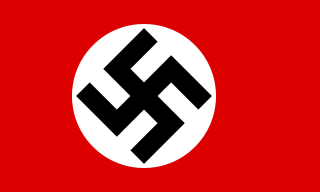 W
WThe Reichskommissariat Ostland (RKO) was established by Nazi Germany in 1941 during World War II. It became the civilian occupation regime in the Baltic states and the western part of the Byelorussian Soviet Socialist Republic. German planning documents initially referred to an equivalent Reichskommissariat Baltenland. The political organization for this territory – after an initial period of military administration before its establishment – involved a German civilian administration, nominally under the authority of the Reich Ministry for the Occupied Eastern Territories led by Nazi ideologist Alfred Rosenberg, but actually controlled by the Nazi official Hinrich Lohse, its appointed Reichskommissar.
 W
WThe occupation of the Baltic states involved the military occupation of the three Baltic states—Estonia, Latvia and Lithuania—by the Soviet Union under the auspices of the 1939 Molotov–Ribbentrop Pact in June 1940. They were then annexed into the Soviet Union as constituent republics in August 1940, though most Western powers and nations never recognised their incorporation. On 22 June 1941, Nazi Germany attacked the Soviet Union and within weeks occupied the Baltic territories. In July 1941, the Third Reich incorporated the Baltic territory into its Reichskommissariat Ostland. As a result of the Red Army's Baltic Offensive of 1944, the Soviet Union recaptured most of the Baltic states and trapped the remaining German forces in the Courland pocket until their formal surrender in May 1945.
 W
WThe 3rd Estonian SS Volunteer Brigade was a formation of the German Waffen-SS during World War II. It was formed in May 1943, when the Estonian SS Legion was upgraded. The first name chosen for the brigade was the Estonian SS Volunteer Brigade, until October 1943, when all SS brigades were numbered so it finally became the 3rd Estonian Volunteer Brigade. The brigade was expanded to a division and renamed on January 23, 1944.
 W
WThe 20th Waffen Grenadier Division of the SS was a foreign infantry division of the Waffen-SS, an armed branch of the German Nazi Party that served alongside but was never formally part of the Wehrmacht during World War II. According to some sources, the division was under Reichsführer-SS Heinrich Himmler's overall command but was not an integral part of the Schutzstaffel (SS). It was officially activated on 24 January 1944, and many of its soldiers had been members of the Estonian Legion and/or the 3rd Estonian SS Volunteer Brigade, which had been fighting as part of German forces since August 1942 and October 1943 respectively. Both of the preceding formations drew their personnel from German-occupied Estonia. Shortly after its official activation, widespread conscription within Estonia was announced by the German occupying authorities. The division was formed in Estonia around a cadre comprising the 3rd Estonian SS Volunteer Brigade, and was initially known as the 20th Estonian SS Volunteer Division.
 W
WThis is a sub-article to Battle of Narva.
 W
WThe Battle of Narva was a military campaign between the German Army Detachment "Narwa" and the Soviet Leningrad Front fought for possession of the strategically important Narva Isthmus on 2 February – 10 August 1944 during World War II.
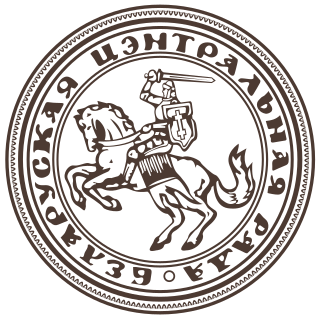 W
WThe Belarusian Central Council was a puppet administrative body in German-occupied Belarus during World War II. It was established by Nazi Germany within Reichskommissariat Ostland in 1943–44, following requests by collaborationist Belarusian politicians hoping to create an independent Belarusian state with German support.
 W
WThe Bielski partisans were a unit of Jewish partisans who rescued Jews from extermination and fought the German occupiers and their collaborators around Nowogródek (Navahrudak) and Lida in German-occupied Poland. The partisan unit was named after the Bielskis, a family of Polish Jews who organized and led the community.
 W
WFollowing the occupation of Latvia by Nazi Germany in the summer of 1941, the Daugavpils Ghetto was established in an old fortress near Daugavpils. Daugavpils is the second largest city in Latvia, located on the Daugava River in the southeastern, Latgale, region of Latvia. The city was militarily important as a major road and railway junction. Before World War II, Daugavpils was the center of a thriving Jewish community in the Latgale region and one of the most important centers of Jewish culture in eastern Europe. Over the course of the German occupation of Latvia, the vast majority of the Jews of Latgale were killed as a result of the Nazi extermination policy.
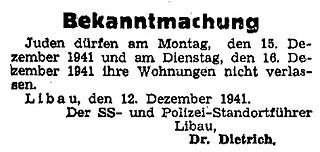 W
WFritz Dietrich was a German SS officer and member of the Nazi Party. He held a doctoral degree in chemistry and physics. His name is also seen as Emil Diedrich. He was hanged for war crimes.
 W
WOtto-Heinrich Drechsler was the General Commissioner of Latvia for the Nazi Germany's occupation regime during World War II. In this capacity, he played a role in setting up the Riga ghetto and was implicated in the extermination of the Latvian Jews. He committed suicide on 5 May 1945, after being captured by the British forces.
 W
WThe Dubingiai massacre was a mass murder of 20–27 Lithuanian civilians in the town of Dubingiai (Dubinki) on 23 June 1944. The massacre was carried out by the 5th Brigade of Armia Krajowa (AK), a Polish resistance group, in reprisal for the Glinciszki (Glitiškės) massacre of Polish civilians committed by the Nazi-subordinated Lithuanian Auxiliary Police Battalion on 20 June 1944. The Dubingiai massacre started a wider AK operation in which units beyond the 5th Brigade were involved. In total, 70–100 Lithuanians were killed by the end of June 1944 in Dubingiai and the neighbouring villages of Joniškis, Inturkė, Bijutiškis, and Giedraičiai. While Nazi collaborators were ostensibly the prime targets, the victims also included the elderly, children, including infants of 4 and 11 months. Further conflicts between Lithuanian and Polish units were prevented by the Soviet capture of Vilnius in mid-July.
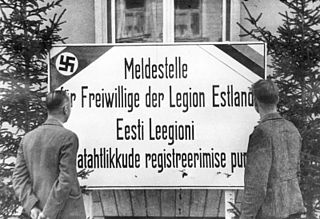 W
WThe Estonian Legion was a military unit within the Combat Support Forces of the Waffen SS during World War II, mainly consisting of Estonian soldiers.
 W
WThe Fareynikte Partizaner Organizatsye was a Jewish resistance organization based in the Vilna Ghetto that organized armed resistance against the Nazis during World War II. The clandestine organisation was established by Communist and Zionist partisans. Their leaders were writer Abba Kovner, Josef Glazman and Yitzhak Wittenberg.
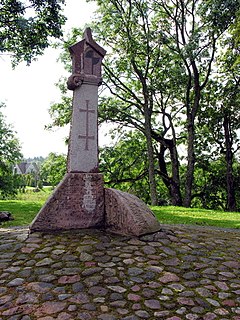 W
WThe Fatherland Defense Force or Kampfgruppe Mäder was a short-lived military unit hastily formed in northwestern Lithuania towards the end of World War II to combat approaching Soviet forces. Formed from local Lithuanians, the unit was directly subordinate to the Wehrmacht. Their German commander was Hellmuth Mäder who was hoping to raise a division. However, only two ill-equipped and ill-trained regiments were actually formed. The total membership is estimated at 6,000 men. On October 7, TAR took defensive positions in Seda against the 19th Tank Corps of the 6th Guards Army. TAR suffered heavy losses and retreated towards Klaipėda (Memel). In East Prussia, the remaining men were reassigned to various pioneer units.
 W
WThe Glinciszki (Glitiškės) massacre was a mass murder of Polish civilians by the Nazi-subordinated Lithuanian Auxiliary Police Battalion, committed on 20 June 1944 in the village of Glinciszki or Glitiškės during World War II. In the massacre, at least 27 civilians were murdered, including 12 women, 11 children, and 6 elderly men. They were executed as a collective punishment for the death of four Lithuanian Nazi policemen on the previous evening, during the skirmish with the Polish resistance units of the 5th Brigade of Armia Krajowa commanded by Lieutenant Wiktor Wiącki. In revenge, Armia Krajowa killed 20–27 Lithuanian civilians in Dubingiai massacre two days later.
 W
WCurt Gustav Friedrich Walther von Gottberg was a high-ranking Nazi official and SS commander. Beginning in October 1942, within a few years he combined the highest civil and military powers in occupied Belarus: from March 1943 as representative of the Higher SS and Police Leader for central Russia and from October 1943 as the acting Commissioner-General (Generalkommissar) of the occupied Belarus.
 W
WHKP 562 was the site of a Nazi forced labor camp for Jews in Vilnius, Lithuania, during the Holocaust. Located at 47 & 49 Subačiaus Street, in apartment buildings originally built to house poor members of the Jewish community, the camp was used by the German army as a slave labor camp from September 1943 until July 1944. During that interval, the camp was officially owned and administered by the SS, but run on a day-to-day basis by a Wehrmacht engineering unit, Heereskraftfahrpark (HKP) 562, stationed in Vilnius. HKP 562's commanding officer, Major Karl Plagge, was sympathetic to the plight of his Jewish workers. Plagge and some of his men made efforts to protect the Jews of the camp from the murderous intent of the SS. It was partially due to the covert resistance to the Nazi policy of genocide toward the Jews by members of the HKP 562 engineering unit that over 250 Jewish men, women and children survived the final liquidation of the camp in July 1944, the single largest group of Jewish survivors of the Holocaust in Vilnius.
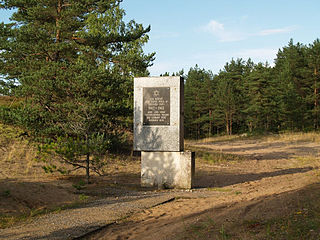 W
WJägala concentration camp was a labour camp of the Estonian Security Police and SD during the German occupation of Estonia during World War II. The camp was established in August 1942 on a former artillery range of the Estonian Army near the village of Jägala, Estonia. It existed from August 1942 to August 1943. Aleksander Laak, an Estonian was appointed by SS-Sturmbannführer Ain-Ervin Mere of Group B of the Estonian Security Police to command the camp with Ralf Gerrets as assistant.
 W
WFriedrich Jeckeln was a German SS commander during the Nazi era. He served as a Higher SS and Police Leader in the occupied Soviet Union during World War II. Jeckeln was the commander of one of the largest collection of Einsatzgruppen death squads and was personally responsible for ordering and organizing the deaths of over 100,000 Jews, Romani, and others designated by the Nazis as "undesirables". After the end of World War II in Europe, Jeckeln was convicted of war crimes by a Soviet military tribunal in Riga and executed in 1946.
 W
WThe Jungfernhof concentration camp was an improvised concentration camp in Latvia, at the Mazjumprava Manor, near the Šķirotava Railway Station about three or four kilometers from Riga. The camp was in operation from December 1941 through March 1942, and served as overflow housing for Jews from Germany and Austria, who had originally been intended for Minsk as a destination.
 W
WKaiserwald (Ķeizarmežs) was a Nazi concentration camp near the Riga suburb of Mežaparks in modern-day Latvia.
 W
WThe Kaunas massacre of October 29, 1941, also known as the Great Action, was the largest mass murder of Lithuanian Jews.
 W
WKhatyn was a village of 26 houses and 157 inhabitants in Belarus, in Lahoysk Raion, Minsk Region, 50 km away from Minsk. On 22 March 1943, almost the entire population of the village was massacred by the Schutzmannschaft Battalion 118 in retaliation for an attack on German troops by Soviet partisans. The battalion was composed of Nazi collaborators and assisted by the Dirlewanger Waffen-SS special battalion.
 W
WKlooga concentration camp was a Nazi forced labor subcamp of the Vaivara concentration camp complex established in September 1943 in Harju County, during World War II, in German-occupied Estonia near the village of Klooga. The Vaivara camp complex was commanded by German officers Hans Aumeier, Otto Brennais and Franz von Bodmann and consisted of 20 field camps, some of which existed only for short periods.
 W
WErich Koch was a Gauleiter of the Nazi Party (NSDAP) in East Prussia from 1 October 1928 until 1945. Between 1941 and 1945 he was Chief of Civil Administration of Bezirk Bialystok. During this period, he was also the Reichskommissar in Reichskommissariat Ukraine from September 1941 until August 1944 and in Reichskommissariat Ostland from September 1944. After the Second World War, Koch stood trial in Poland and was convicted in 1959 of war crimes and sentenced to death. The sentence was never carried out and Koch died of natural causes in his cell at the Barczewo prison on the 12 November 1986.
 W
WThe Koniuchy (Kaniūkai) massacre was a World War II massacre of civilians, mostly women and children, carried out in the village of Koniuchy on 29 January 1944 by a Soviet partisan unit together with a contingent of Jewish partisans under Soviet command. At least 38 civilians who have been identified by name were killed, and more than a dozen were injured. In addition, houses were burned and livestock was slaughtered. It was the largest atrocity committed by the Soviet partisans in present-day Lithuania.
 W
WWilhelm Kube was a Nazi official and German politician. He was an important figure in the German Christian movement during the early years of Nazi rule. During the war he became a senior official in the occupying government of the Soviet Union, achieving the rank of Generalkommissar for Weissruthenien (Belarus). He was assassinated in Minsk in 1943, triggering brutal reprisals against the citizens of Minsk.
 W
WLatvian Auxiliary Police was a paramilitary force created from Latvian volunteers by the Nazi German authorities who occupied the country in June 1941. It was part of the Schutzmannschaft (Shuma), native police forces organized by the Germans in occupied territories and subordinated to the Order Police. Some units of the Latvian auxiliary police were involved in the Holocaust. One of its units, the Arajs Kommando, was notorious for killing 26,000 civilians during the war, mostly Jews, but also Communists and Romas.
 W
WHinrich Lohse was a Nazi German politician and a convicted war criminal, best known for his rule of the Reichskommissariat Ostland, during World War II. Reichskommissariat Ostland now comprises Lithuania, Latvia, Estonia, and parts of modern day Belarus.
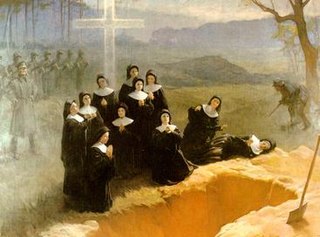 W
WThe Martyrs of Nowogródek, also known as the Blessed Martyrs of Nowogródek and the Eleven Nuns of Nowogródek or Blessed Mary Stella and her Ten Companions were a group of members of the Sisters of the Holy Family of Nazareth, a Polish Roman Catholic religious congregation, executed by the Gestapo in August 1943 in occupied Poland. They have been declared Blessed by virtue of martyrdom by Pope John Paul II on 5 March 2000.
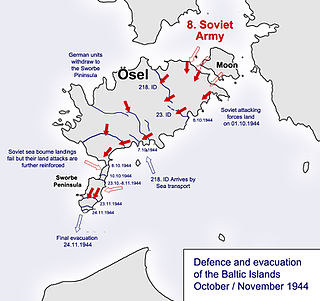 W
WThe Moonsund landing operation, also known as the Moonzund landing operation, was an amphibious operation and offensive by the Red Army during World War II, taking place in late 1944. It was part of the Baltic offensive, and was designed to clear German forces of Army Group North from the islands in East Baltic Sea, the West Estonian archipelago. The attacking forces were from the 8th Army of the Leningrad Front.
 W
WThe Narva offensive was an operation conducted by the Soviet Leningrad Front. It was aimed at the conquest of the Narva Isthmus from the German army detachment "Narwa". At the time of the operation, Joseph Stalin, the supreme commander of the Soviet Armed Forces, was personally interested in taking Estonia, viewing it as a precondition to forcing Finland out of the war.
 W
WThis is a sub-article to Battle of Narva (1944).
 W
WThis is a sub-article to Battle of Narva.
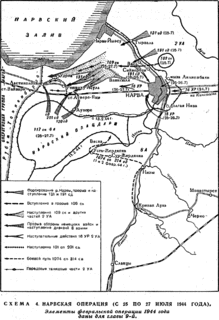 W
WThis is a sub-article to Battle of Narva (1944).
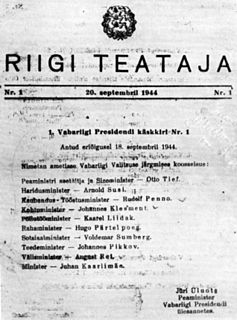 W
WThe National Committee of the Republic of Estonia was a self-styled resistance movement in German-occupied Estonia in March 1944. By April 1944 a large number of the committee members were arrested by the German security agencies.
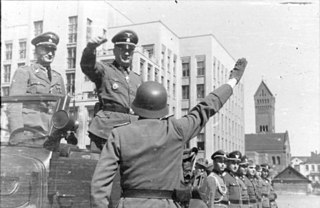 W
WOperation Hornung was an anti-partisan operation during the Occupation of Belarus by Nazi Germany, carried out in February 1943. It was directed against the area Hancewicze-Morocz-Lenin-Łuniniec, a thinly populated area of about 4,000 square kilometers southwest of Słuck on the southern border of the Regional Commissariat White Ruthenia. It came in the sequence of three actions that had taken place in January further to the northeast, in the area of Słuck-Osipowicze; it claimed over 12,000 victims.
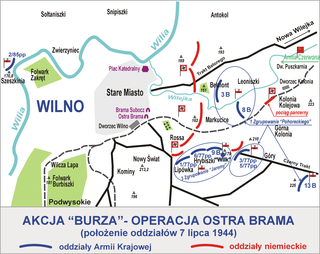 W
WOperation Ostra Brama was an attempt by the Polish Home Army to take over Vilnius from Nazi Germany's evacuating troops ahead of the approaching Soviet Vilnius Offensive. A part of a Polish national uprising, Operation Tempest, the action began on 7 July 1944 and lasted until 14 July 1944.
 W
WThe Ponary massacre or Paneriai massacre was the mass murder of up to 100,000 people, mostly Jews, Poles, and Russians, by German SD and SS and their Lithuanian collaborators, including Ypatingasis būrys killing squads, during World War II and the Holocaust in Reichskommissariat Ostland. The murders took place between July 1941 and August 1944 near the railway station at Ponary, a suburb of today's Vilnius, Lithuania. Some 70,000 Jews were murdered at Ponary, along with up to 20,000 Poles, and 8,000 Russian POWs, most of them from nearby Vilna (Vilnius), and its newly-formed Vilna Ghetto.
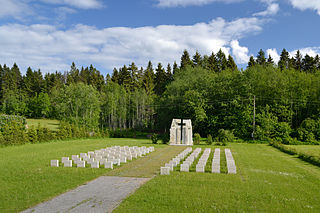 W
WBattle of Porkuni was the largest engagement between Estonians serving in the Red Army and Estonian pro-independence and Waffen-SS units. It took place on 21 September 1944 between Lake Porkuni and the Sauvälja village about seven kilometres northeast of the town of Tamsalu during the Leningrad Front's Tallinn Offensive Operation.
 W
WKarl-Siegmund Litzmann was General Commissioner for Estonia in the Reichskommissariat Ostland during the German occupation.
 W
WThe Riga Ghetto was a small area in Maskavas Forštate, a neighbourhood of Riga, Latvia, designated by the Nazis where Jews from Latvia, and later from Germany, were forced to live during World War II. On October 25, 1941, the Nazis relocated all Jews from Riga and its vicinity to the ghetto while the non-Jewish inhabitants were evicted. Most of the Latvian Jews were killed on November 30 and December 8, 1941 in the Rumbula massacre. The Nazis transported a large number of German Jews to the ghetto; most of them were later killed in massacres.
 W
WEduard Roschmann was an Austrian Nazi SS-Obersturmführer and commandant of the Riga ghetto during 1943. He was responsible for numerous murders and other atrocities. As a result of a fictionalized portrayal in the novel The Odessa File by Frederick Forsyth and its subsequent film adaptation, Roschmann came to be known as the "Butcher of Riga".
 W
WThe Rumbula massacre is a collective term for incidents on November 30 and December 8, 1941, in which about 25,000 Jews were killed in or on the way to Rumbula forest near Riga, Latvia, during the Holocaust. Except for the Babi Yar massacre in Ukraine, this was the biggest two-day Holocaust atrocity until the operation of the death camps. About 24,000 of the victims were Latvian Jews from the Riga Ghetto and approximately 1,000 were German Jews transported to the forest by train. The Rumbula massacre was carried out by the Nazi Einsatzgruppe A with the help of local collaborators of the Arajs Kommando, with support from other such Latvian auxiliaries. In charge of the operation was Höherer SS und Polizeiführer Friedrich Jeckeln, who had previously overseen similar massacres in Ukraine. Rudolf Lange, who later participated in the Wannsee Conference, also took part in organizing the massacre. Some of the accusations against Latvian Herberts Cukurs are related to the clearing of the Riga Ghetto by the Arajs Kommando. The Rumbula killings, together with many others, formed the basis of the post-World War II Einsatzgruppen trial where a number of Einsatzgruppen commanders were found guilty of crimes against humanity.
 W
WSalaspils camp was established at the end of 1941 at a point 18 km (11 mi) southeast of Riga (Latvia), in Salaspils. The Nazi bureaucracy drew distinctions between different types of camps. Officially, it was the Salaspils Police Prison and Re-Education Through Labor Camp. It was also known as camp Kurtenhof after the German name for the city of Salaspils. Planning for the development of the camp and its prisoner structure changed several times. In 1943, Heinrich Himmler briefly considered converting the camp into an official concentration camp (Konzentrationslager), which would have formally subordinated the camp to the National Security Main Office, but nothing came of this. The camp has had a lasting legacy in Latvian and Russian culture due to the severity of the treatment at the camp, especially with regard to children.
 W
WThe Slutsk affair refers to the massacre of thousands of Jews and others that occurred in Slutsk, Belarus in the Soviet Union, in October 1941, near the city of Minsk while under German occupation during World War II. The perpetrators were a combination of Gestapo special forces and Lithuanian allies of the Third Reich. Nearly 4,000 Jews were murdered over a two-day period along with thousands of non-Jews.
 W
WJakob Sporrenberg was an SS-Gruppenführer und Generalleutnant der Polizei in Minsk, Belarus and Lublin, Poland. After the war, Sporrenberg stood trial in Poland and was convicted in 1950 of war crimes and sentenced to death. He was executed in December 1952.
 W
WThis is a sub-article to Battle of Narva (1944).
 W
WThe Tartu offensive operation, also known as the Battle of Tartu and the Battle of Emajõgi was a campaign fought over southeastern Estonia in 1944. It took place on the Eastern Front during World War II between the Soviet 3rd Baltic Front and parts of the German Army Group North.
 W
WVaivara was the largest of the 22 concentration and labor camps established in Estonia by the Nazi regime during World War II. It had 20,000 Jewish prisoners pass through its gates, mostly from the Vilna and Kovno Ghettos, but also from Latvia, Poland, Hungary and the Theresienstadt concentration camp. Vaivara was one of the last camps to be established. It existed from August 1943 to February 1944.
 W
WGeneral Michał Vituška was a Belarusian leader of the Black Cats, a unit of the SS-Jagdverbände, during World War II.